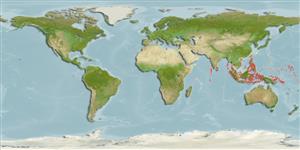>
Gobiiformes (Gobies) >
Gobiidae (Gobies) > Gobiinae
Etymology: Gladiogobius: Latin, gladius = sword + Latin, gobius = gudgeon (Ref. 45335).
More on author: Herre.
Environment: milieu / climate zone / depth range / distribution range
Οικολογία
Θαλασσινό(ά); Υφάλμυρο Υφαλόφιλο(α); εύρος βάθους 0 - 3 m (Ref. 90102). Tropical; 30°N - 9°S
Indo-Pacific: Red Sea to western New Guinea, north to the Yaeyamas in the southern Ryukyus; Palau in Micronesia.
Μέγεθος / Βάρος / Age
Maturity: Lm ? range ? - ? cm
Max length : 7.5 cm SL αρσενικό/απροσδιόριστο; (Ref. 48637)
Short description
Κλείδες προσδιορισμού | Μορφολογία | Μορφομετρία
Ραχιαίες άκανθες (συνολικά) : 7; Μαλακές ραχιαίες ακτίνες (συνολικά) : 10; Εδρικές άκανθες: 1; Μαλακές εδρικές ακτίνες: 10. Large spine at lower posterior edge of preoperculum; characterized further by pale grey body color with narrow brown stripes and longitudinal rows of small white dots on side of body; lower side of body with row of five large rectangular brown blotches; irregular brown saddles along back; large grey spot above base of pectoral fin; elongate and filamentous fourth dorsal spine; rounded caudal fin; longitudinal scale series 23-25; head and nape without scales; ctenoid body scales except cycloid on abdomen, base of pectoral fin and prepelvic region; median predorsal scales absent; opening of gill not reaching to above edge of preopercle; moderately long cheek spine, 21-27% head length, not reaching posterior margin of opercular membrane; depth of body 4.8-5.4 in SL (Ref. 90102).
Inhabits tide pools of sandy intertidal areas of lagoons, bays, and river mouths. Also lives in sheltered sandy bays and estuaries among rubble and in lagoons along edges of coral patches. Usually found in small loose groups (Ref. 48637).
Life cycle and mating behavior
Γεννητική Ωρίμανση | Αναπαραγωγή | Γεννοβολία | Αβγά | Γονιμότητα | Προνύμφες
Myers, R.F., 1991. Micronesian reef fishes. Second Ed. Coral Graphics, Barrigada, Guam. 298 p. (Ref. 1602)
IUCN Red List Status (Ref. 130435: Version 2024-2)
Threat to humans
Harmless
Human uses
αλιεία: χωρίς ενδιαφέρον
Εργαλεία
Special reports
Download XML
Διαδικτυακές πηγές
Estimates based on models
Preferred temperature (Ref.
123201): 28 - 29.4, mean 28.8 °C (based on 1165 cells).
Phylogenetic diversity index (Ref.
82804): PD
50 = 0.6250 [Uniqueness, from 0.5 = low to 2.0 = high].
Bayesian length-weight: a=0.01023 (0.00477 - 0.02194), b=3.01 (2.83 - 3.19), in cm total length, based on LWR estimates for this (Sub)family-body shape (Ref.
93245).
Τροφικό Επίπεδο (Ref.
69278): 3.3 ±0.4 se; based on size and trophs of closest relatives
Ελαστικότητα (Ref.
120179): Υψηλό, ελάχιστος χρόνος για διπλασιασμό πληθυσμού < 15 μήνες (Preliminary K or Fecundity.).
Fishing Vulnerability (Ref.
59153): Low vulnerability (10 of 100).
